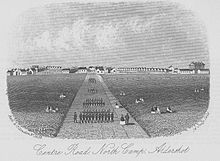Aldershot Garrison
The Aldershot Garrison , also known as Aldershot Military Town or The Home of the British Army , is a large British Army military facility located near the city of Aldershot . It was founded in 1854.
history
In the 25 years of supreme command of Wellington , victor over Napoleon in the Battle of Waterloo , there had been a stagnation in the development of the British Army. This became evident in the Crimean War . Therefore, Wellington's successor Henry Hardinge, 1st Viscount Hardinge, was asked by Prince Albert to improve the training of the British Army. This is how the Aldershot camp ( The Home of the British Army ) was established. The construction of the largest base of the British Army led to a massive increase in the population in Aldershot. The population rose from 875 in 1851 to 16,000 in 1861 (including 9,000 members of the military). In Victorian England, Aldershot was synonymous with the training of the British Army. Wellington's equestrian statue was relocated here in 1883 after initially being placed on Wellington Arch in London in 1846 .
In 1872 the Aldershot narrow-gauge suspension railway was operated on the site . In January 1876 a mobilization plan was presented to the British Army with eight army corps . The II Corps was stationed in Aldershot as the Aldershot Command or Aldershot District Command . When Queen Victoria's son , the Duke of Connaught and Strathearn , assumed this post, the corps became first on the list of corps.
By Army Order 324 of August 21, 1914, Lord Kitchener set up the so-called Kitchener's Army , most of which were trained in Aldershot. During a visit by King George V in September 1914, 130,000 men were stationed here.
On February 22, 1972, the Irish Republican Army carried out a terrorist attack on the Parachute Brigade headquarters in Aldershot. This was an act of revenge for Bloody Sunday , on which 13 people in Ireland were shot by soldiers of this unit. Seven civilians died in the attack.
Commander of the Aldershot Garrison
The post of Garrison Commander Aldershot has historically been an important position in the British Army and has been held by well-known figures such as John French , Douglas Haig and Bernard Montgomery . Over the past 160 years, this position has had various names, depending on the name given to the garrison itself.
Aldershot Division
- 1857 to 1860 William Knollys
- 1860 to 1865 John L. Pennefather
- 1865 to 1870 James Yorke Scarlett
- 1870 to 1875 Hope Grant
- 1875 to 1880 Thomas Montagu Steele
Aldershot District Command
- 1880 to 1883 Daniel Lysons
- 1883 to 1889 Archibald Alison, 2nd Baronet
- 1889 to 1893 Evelyn Wood
- 1893 to 1898 Arthur, 1st Duke of Connaught and Strathearn
- 1898 Redvers Buller
- 1900 William Francis Butler (during Buller's service in the Boer War )
Commanding General of the 1st Army Corps and Lieutenant-General Commanding Troops Aldershot
- 1901 Redvers Buller (on his return)
- 1902 John French, 1st Earl of Ypres
Aldershot Command
- 1907 to 1912 Horace Smith-Dorrien
- 1912 to 1914 Douglas Haig
- 1914 to 1917 Archibald Hunter
- 1917 to 1919 Archibald Murray
- 1919 to 1920 Henry Rawlinson, 1st Baron Rawlinson
- 1920 to 1922 Rudolph Lambart Earl of Cavan
- 1922 to 1923 Thomas Morland
- 1923 to 1927 Philip Walhouse Chetwode, 1st Baron Chetwode
- 1927 to 1931 David Campbell
- 1937 to 1939 John Dill
South Eastern Command
- 1941 Bernard Paget
- 1941 to 1942 Bernard Montgomery
- 1944 Edmond Schreiber
The Aldershot Garrison today
Today the Aldershot garrison has about 10,500 inhabitants. The garrison contains several landmarks such as the observatory , the Wellington statue, the military cemetery and the Royal Garrison Church of All Saints . The Roman Catholic military ordinariate of Great Britain has also been located on the site of the garrison since 1953 .
Today are stationed here:
- HQ South East
- HQ 11th Infantry Brigade
- HQ 101st Logistic Brigade
- 1st Battalion, Grenadier Guards
- 1st Battalion, Guardsman
- 4th Battalion, The Rifles
- 3rd regiment Royal Logistic Corps
- 4 Armored Medical Regiment
- 4th Regiment Royal Military Police
- 10 Queen's Own Gurkha Logistic Regiment
- 29 EOD & Search Group
- 22 Field Hospital
The Army plans to build the new South East Super Garrison in Aldershot . Various locations are then to be combined in this.
Web links
Individual evidence
- ↑ Origins of the Military Town
- ^ Paul H. Vickers: Aldershot Military Town - a brief history . Friends of the Aldershot Military Museum, 2011, p. 1.
- ^ Transforming the British Army: an update . Ministry of Defense. Retrieved May 6, 2016.
Coordinates: 51 ° 15 ′ 40 ″ N , 0 ° 45 ′ 10 ″ W.




